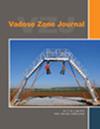Hydro‐pedo‐transfer‐functions expressing drought and memory effects on pine tree growth
IF 2.8
3区 地球科学
Q3 ENVIRONMENTAL SCIENCES
引用次数: 0
Abstract
Over the last 30 years, the impact of climate change in Berlin, Germany, has manifested in the form of reduced summer rainfall, elevated temperatures, and a notable rise in the frequency of days with temperatures surpassing 30°C. All of them are leading to a decreasing water supply and increasing risk of drought. Various field, laboratory, and numerical simulation studies have been done for deriving information on long‐term potential and actual evapotranspiration, water stress during the vegetation period (April–September), and tree ring growth of various pine tree stands in Berlin. Data analysis highlights periodical climate patterns and complex interactions between drought, water supply, and plant growth. Annual tree ring growth is not only related to the actual weather conditions but also to the past climate years. With decreasing water supply, this kind of drought memory effect increases up to 5 years into the past. For Berlin's climate, it is noteworthy that late summer, particularly the water stress in August, represents the most sensitive indicator for tree ring growth.For regionalization purposes, long‐term numerical simulations were done to derive hydro‐pedo‐transfer‐functions (HPTFs) predicting the water stress coefficient of the growing season (表达干旱和记忆对松树生长影响的水力渗透转移功能
在过去的 30 年中,气候变化对德国柏林的影响表现为夏季降雨量减少、气温升高以及气温超过 30°C 的天数明显增加。所有这些都导致供水减少,干旱风险增加。为了获得柏林各种松树林长期潜在和实际蒸散量、植被期(4 月至 9 月)水分胁迫和树环生长的信息,我们进行了各种实地、实验室和数值模拟研究。数据分析突出了周期性气候模式以及干旱、供水和植物生长之间复杂的相互作用。树木年轮的生长不仅与实际天气条件有关,还与过去的气候年份有关。随着供水量的减少,这种干旱记忆效应会增加到过去 5 年。对于柏林的气候而言,值得注意的是,夏末,尤其是 8 月份的水压力,是树环生长最敏感的指标。为了实现区域化,我们进行了长期数值模拟,以得出预测生长季节水压力系数(Eact-s/Epot-s)的水力渗透转移函数(HPTFs)。这些函数只需要简单易得的信息,如土壤质地、气候水分平衡和地下水深度。两个 HPTF 已成功通过测试,并可轻松应用于地理信息系统。不过,对于其他气候区和树种,HPTFs 还需要进行调整。
本文章由计算机程序翻译,如有差异,请以英文原文为准。
求助全文
约1分钟内获得全文
求助全文
来源期刊

Vadose Zone Journal
环境科学-环境科学
CiteScore
5.60
自引率
7.10%
发文量
61
审稿时长
3.8 months
期刊介绍:
Vadose Zone Journal is a unique publication outlet for interdisciplinary research and assessment of the vadose zone, the portion of the Critical Zone that comprises the Earth’s critical living surface down to groundwater. It is a peer-reviewed, international journal publishing reviews, original research, and special sections across a wide range of disciplines. Vadose Zone Journal reports fundamental and applied research from disciplinary and multidisciplinary investigations, including assessment and policy analyses, of the mostly unsaturated zone between the soil surface and the groundwater table. The goal is to disseminate information to facilitate science-based decision-making and sustainable management of the vadose zone. Examples of topic areas suitable for VZJ are variably saturated fluid flow, heat and solute transport in granular and fractured media, flow processes in the capillary fringe at or near the water table, water table management, regional and global climate change impacts on the vadose zone, carbon sequestration, design and performance of waste disposal facilities, long-term stewardship of contaminated sites in the vadose zone, biogeochemical transformation processes, microbial processes in shallow and deep formations, bioremediation, and the fate and transport of radionuclides, inorganic and organic chemicals, colloids, viruses, and microorganisms. Articles in VZJ also address yet-to-be-resolved issues, such as how to quantify heterogeneity of subsurface processes and properties, and how to couple physical, chemical, and biological processes across a range of spatial scales from the molecular to the global.
 求助内容:
求助内容: 应助结果提醒方式:
应助结果提醒方式:


